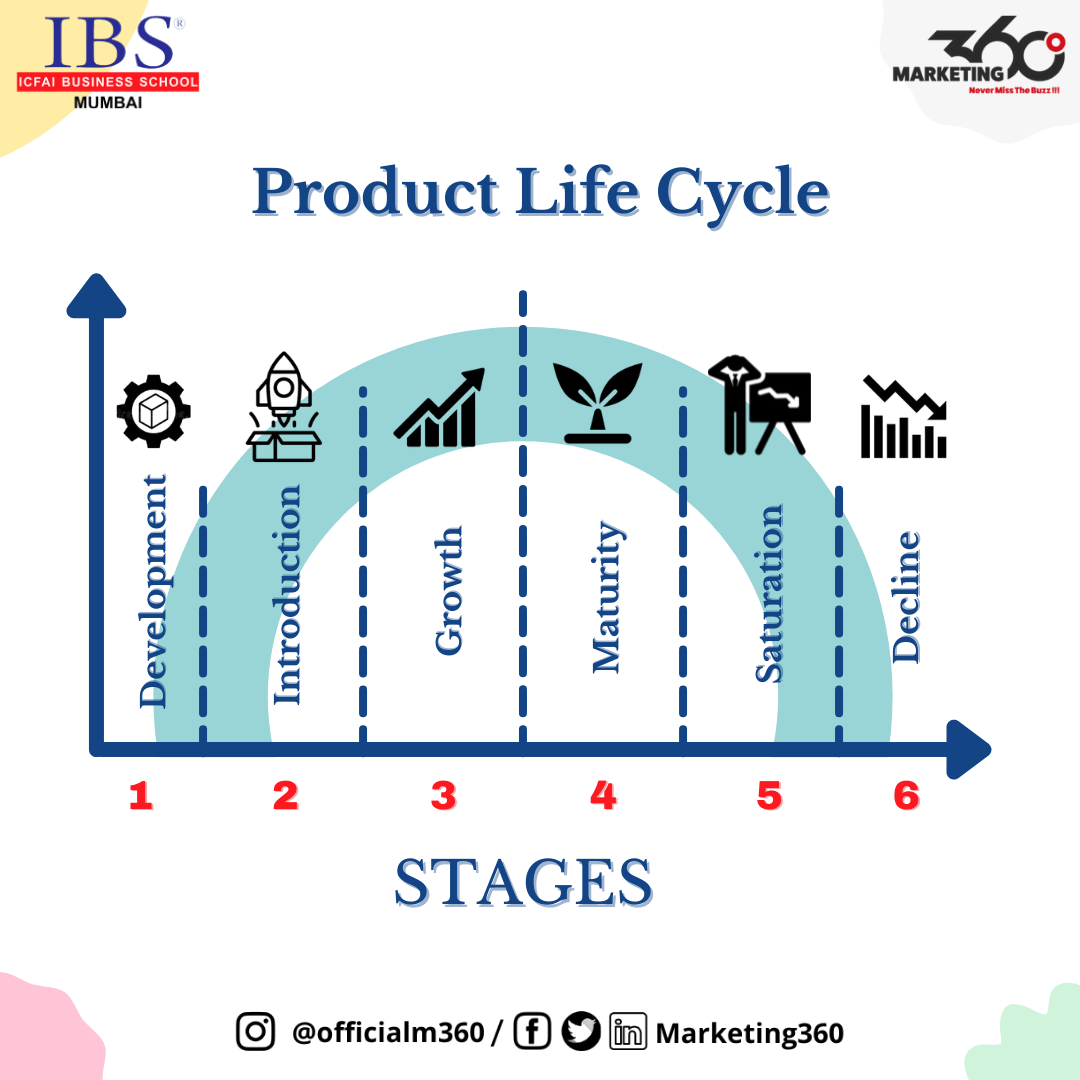
Key Takeaways:
- The products have a limited life in a product life cycle.
- Product sales go through various stages with different opportunities, challenges, and problems for the seller.
- Product sales have clearly defined stages.
- Revenue change at every stage of the Product Life Cycle
- Different marketing strategies are required at every stage of the Product Life
What is Product Life Cycle (PLC)?
The Product Life Cycle refers to the time it takes for a product to be developed, brought to market, and then removed from the market. The Product Life Cycle (PLC) is a useful tool for analyzing and planning marketing mix activities. Product Life Cycle is based on a metaphor that treats products as people and assumes they are born (introduction), develop (grow), age (mature), and die (decline).
The Product life cycle acknowledges that most Products have a finite market life, whether it is brief, as in the case of fashion items, or long, as in the case of some types of industrial equipment. Only through the Product Life Cycle can you analyze how a product acts from its development to its withdrawal from the market, considering its introduction, growth, and sales maturity. The Product Life Cycle is a five-stage concept proposed by Levitt.
For more details, please visit our social media page – [Link: https://instagram.com/officialm360?utm_medium=copy_link]
Kotler (2000:303) see the concept as implying the following:
- Products have a limited life in a Product Life Cycle.
- Product sales go through various stages with different opportunities, challenges and problems for the seller and depending upon the stages the strategies is been used by the company.
- At different stages of the product life cycle, revenue rises and falls.
- Products require different strategies in each life cycle stage such as marketing, financial, manufacturing, purchasing, and human resources.
The product life cycle is the concept where the product goes through several stages of its life:
- Product Development stage.
- Product Introduction stage.
- Product Growth stage.
- Product Maturity stage.
- Product Saturation stage.
- Product Decline stage.
1. Product Development Phase
When a firm discovers and develops a new product concept, the product development phase begins. This entails taking a variety of pieces of data and combining them into a new product.
During product development, the product generally goes through various revisions that cost a lot of money and time before being introduced to target customers via test markets.
During the product development phase, sales are zero and profits are negative. It is the time of spending on your product with absolutely no return on investment.
2. Introduction Phase
The product launch phase of a project comprises the criteria for having the product launched in such a way that it has the most impact at the point of sale. Microsoft Corporation’s introduction of “Windows XP” is a good example of such a launch.
During this period, a firm should also think about pricing. Pricing for products typically follows one or two well-defined strategies. Early adopters will pay a premium for anything new, which will assist to mitigate the pitfall stated previously. Later, the price policy should be more aggressive for the product to compete.
Another method is to use pre-determined pricing that is thought to be the best for maximizing sales. This, on the other hand, requires a thorough understanding of the market and whether a consumer is prepared to spend for a freshly presented product. Actions made by the firm before the product’s release to the market may also contribute to a successful product launch phase.
Customer feedback on design, pricing, service, and packaging is crucial in the development of a product design. A client may inform the firm which aspects of a product are attractive and which features should not be included in the product.
3. Growth Phase
The Growth stage is when your product’s market share begins to increase. Often, a significant amount of money is spent on sales and marketing at this time. The Company’s advertising efforts should be targeted at a target demographic and existing consumers and promote the benefits of your products to them. You have numerous options for promoting your goods, and the one you select will depend on your budget.
Increased output and more competitive pricing should boost company earnings.
Few points to consider:
- Enhancing the product’s quality and adding new features or support services
- maintaining price to boost product demand expanding distribution channels to meet demand promoting to a broader audience
Promotion and advertising continue, but not to the same level as in the beginning, and it is focused on maintaining market leadership rather than growing product knowledge. The employment of external promotional contractors is a smart practice. This is the moment to enhance product availability and service while also developing efficiency.
The Chinese market is an excellent example of a “virgin” market. Most western firms and their goods were shut out of this market, but it is progressively opening up to new products and services.) the process of production planning It’s futile to raise consumer expectations and product demand if you don’t have the manufacturing capacity. Overstretching a business is a mistake that must be avoided. A company should not over-commit about the product this is one of the mistake company makes during selling the product. This will result in losing customers not finding the product “on the self”.
4. Maturity Phase
The Maturity stage is the third stage of the Product Life Cycle. If a product has progressed through the Introduction and Growth stages, it will most certainly spend a significant amount of time in the Maturity stage. Following the Growth stage, which saw a rapid surge in sales and client growth, company market share will gradually begin to stabilize during the Maturity period.
Pricing and discount policies are frequently altered in response to competition policies, i.e., pricing moves up and down in lockstep with the competition, and in the case of consumer items, promotions and coupons are introduced. Promotion and advertising shifts away from attracting new consumers and toward product differentiation in terms of quality and dependability.
A good example of this is Tide washing powder which is one of the most reliable company and it is still growing.
5. Saturation Phase
Saturation is a phase of a product where neither there Is moving in terms of growth or decline in a product. During the product saturation stage, competitors have begun to take a portion of the market and products will also start to know how the product is stuck in its phase. It is felt neither growth nor decline.
In actuality, the consumer is aware of the product. This is the point where there are many competing companies. At this point, you try a different experiment in advertising and marketing. Your focus is to make the consumer market aware of your brand.
6. Decline Phase
This is the point at which your product’s sales start to decline. Either everyone who wants it has purchased it, or new, more inventive goods have been developed to take its place. You’ll need to review your present product and modify or iterate its features to be competitive and maintain your market share.
Often companies come up with a high price policy for the declining products that increase the profit margin of the company but it also discourages the Few loyal customers who are still buying the product.
Companies may opt to withdraw altogether from the market if a product is in decline. This is most likely because it is too costly to develop and recreate the product, or because competitors have acquired such a large portion of the market that it is difficult to compete. Consider the many startups that have shut down after several years of operation, losing market share to larger companies.
Let’s Take a good example of the well-known company
Nokia
Introduction:
Nokia was introduced during the year 1865 by Fredrik Ides tam and it is a Finland based multinational company. Nokia started by producing cables, pulp and rubber which many of us did not know. In 1992, the Digi-handheld GSM phone, Nokia 1011 was launched by Nokia. Over some time, it did not provide or launched a variety of models due to its less demand and sale. Both GSM as well as CDMA phones were sold by Nokia eventually.
Growth:
Nokia then launched its first phone without an antenna after a lot of research, which was the Nokia 3210 on March 18, 1999. This model is one of the most popular and successful phones in history with more than 160 million units sold. Nokia then launched phones like N95 when I-phone and Samsung came in competition, to compete with them.
Maturity:
Nokia launched a lot of touch screen models during this stage, one of which was N-97 qwerty+touch which was a huge success and the most profit was gained.
Decline:
What leads to Nokia’s decline was its poor product design and having its main focus on Windows as its OS. Nokia is going through this stage now.
Strategies For Expanding Product Lifespan
It is important to recollect that product lifecycle management is not strict sentencing. It is a framework—thanks to believing your product over time and plan for its future.
Remember that many products and services have existed for years and have never gone out of style. Look to companies like Disney, IBM, and Intel, who regularly surpass themselves. As a product team, your goal should be to increase the product life cycle and reach this legacy status.
Each stage of the product life cycle should be properly monitored because it is fluid and flexible.
Add New Features and Services
Perhaps some aspects of your product lag behind the competition, or perhaps your product has become stale after years on the market. Whatever the reason for your product’s decline stage, it’s going to be time to modify it up. Brand innovation is a consumer selling point. As a result, new product features and services can help you fulfil your customers’ changing wants, challenge your competition, and revive your brand.
Take, for instance, Instagram Stories.
The addition of a replacement option, which allows users to share information that vanishes after 24 hours, changed the game for the social media firm. Instagram added Stories to meet their users’ want for more casual content, fight their primary competitor Snapchat, and address the brand’s poisonous culture. Instagram became the place to share daily moments in between the “Insta-worthy” ones in a single shift toward ephemeral content.
Revitalize Your Brand Packaging
Packaging is powerful.
It’s the first point of contact between brands and consumers, and the last differentiator between comparable products. Packaging can make the changes between a product being considered basic and cheap, or luxurious and chic. One study from Ipsos found that buying decisions for many American consumers are influenced by the planning and material of product packaging.
Anyone who has ever needed scissors to open a package of scissors understands how inconvenient packaging can be. Changing your product’s packaging to ease usage may be a good way to bring new life to tired products.
After years of development and concept testing, for instance, Tide invented the Tide Pod, which radically transformed the laundry process. Consumers raved about the convenience and convenience of the product, and laundry was never an equivalent again.
Packaging is additionally important for developing brand identity – and even brands with global recognition can enjoy shaking up their packaging. In one successful re-packaging strategy, Coca-Cola, for example, replaced its iconic logo with first names and colloquial nicknames. The idea itself led to a rise in sales by quite 2%.
Identify New Markets
You have just discovered limitations in your product’s main target market. Whether the market has become saturated over time or an unexpected downturn within the industry has put your company in a precarious position, there is no got to fear. The globalized world is best suited now than ever before for expansion into new markets – that is if you will make sure the right distribution channels.
Broadening your product’s reach, however, isn’t the sole thanks to set about identifying new markets. Sometimes, developing a market that’s more niche can have equally impactful results.
Create Bold Marketing Campaigns
Not only a creative advertisement does wonders for rejuvenating your brand/Product image but it can also make a real impact on the company product sales. According to a Harvard Business Review research, spending on highly innovative advertising campaigns had nearly twice the sales impact as spending on more conservative approaches.
Take for example Old Spice’s wildly popular ad campaign, “Smell sort of a Man, Man.” Old Spice’s claim to fame—that it’s been selling men’s grooming products since the first 1900s—later surfaced as a major vulnerability. People associated the classic Old Spice scent with their grandfathers, and therefore the last item young men wanted was to smell “old.” With new, younger products like Axe gaining popularity, Old Spice needed a new face to represent their Product/brand.
There are stages that a product goes through. The life of a product is subjective and may have a lifeline depending upon its performance. All the products go through the different Product life cycle stages of development, introduction, growth, maturity, and decline. When an organization classifies that a product has gone into the declining stage or is not performing as expected, it must decline what to do. Organizations need to determine the Product life cycle to set performance goals, such as sales and, growth targets, profit and make allocation of resources decision, such as strategic and human resource planning. To progress an efficacious product during each stage of its life cycle, a company must comprehend how marketing management works for the customer, the market, and competitors. It should evaluate and accordingly distinguish the product and its future sustainability.

Parth Pandya
Content writer

Harsh Shah
Graphic designer

Nishikant Patil
Editor

I truly love your blog.. Very nice colors &
theme. Did you build this site yourself? Please reply back as I’m
attempting to create my own personal site and would like to
know where you got this from or just what the theme is named.
Many thanks!
terima kasih telah berbagi berita Mas, senang sekali rasanya membaca tulisan2 di blog ini, jadi tambah wawasan.. semoga yang mengeleloa blog ini selalu di berikan kesehatan..
Hi, Neat post. There’s a problem together with your
website in web explorer, may test this? IE nonetheless is the market chief and
a huge portion of other people will leave out your fantastic writing due
to this problem.
Good day! Do you use Twitter? I’d like to follow you if that
would be okay. I’m absolutely enjoying your blog and look forward to new posts.
Hello! I’ve been following your blog for some time now and finally
got the courage to go ahead and give you a shout out from
Houston Texas! Just wanted to say keep up the good job!
Thanks.|
Superb website you have here but I was wondering if
you knew of any user discussion forums that cover the same topics discussed here?
I’d really like to be a part of community where I can get responses
from other knowledgeable people that share the same interest.
If you have any suggestions, please let me know.
Appreciate it!
Admiring the persistence you put into your site and detailedinformation you present. It’s awesome to come across a blog every once in a while that isn’t the same old rehashedmaterial. Wonderful read! I’ve saved your site and I’madding your RSS feeds to my Google account.
Piece of writing writing is also a fun, if you be familiar with afterward you can write or
else it is complicated to write.
A person necessarily lend a hand to make severely articles I would
state. That is the first time I frequented your website page and so far?
I amazed with the analysis you made to make this actual publish amazing.
Great process!
Thank you for your sharing. I am worried that I lack creative ideas. It is your article that makes me full of hope. Thank you. But, I have a question, can you help me?
Your article helped me a lot, is there any more related content? Thanks!
Great information. Lucky me I ran across your website by accident (stumbleupon).
I have book-marked it for later!
Look into my web-site; vpn special coupon code 2024
What’s Happening i am new to this, I stumbled upon this I’ve found It positively helpful and it has helped me out loads.
I am hoping to contribute & help other customers like its helped me.
Great job.
Visit my web site :: vpn coupon code 2024
Very great post. I just stumbled upon your blog and wanted to mention that
I’ve truly loved surfing around your blog
posts. After all I’ll be subscribing for your rss feed and I am hoping you write again soon!
I’d like to find out more? I’d love to find
out more details.
Spot on with this write-up, I honestly think this web site needs much more attention.
I’ll probably be returning to see more, thanks for
the info!
Very good info. Lucky me I ran across your blog by chance (stumbleupon).
I have bookmarked it for later!
After checking out a handful of the articles on your site, I honestly appreciate your
technique of blogging. I saved it to my bookmark site list and
will be checking back soon. Please visit my web site too and let me know your opinion.
It’s very easy to find out any matter on net as compared to textbooks, as I found this paragraph at this website.
No matter if some one searches for his required thing, therefore he/she wishes
to be available that in detail, so that thing is
maintained over here.
Generally I do not read post on blogs, but I wish to say that this
write-up very compelled me to try and do so! Your writing style has
been surprised me. Thank you, quite great article.
Oh my goodness! I’m in awe of the author’s writing skills and ability to convey complex concepts in a straightforward and precise manner. This article is a true gem that merits all the applause it can get. Thank you so much, author, for offering your wisdom and providing us with such a priceless treasure. I’m truly grateful!